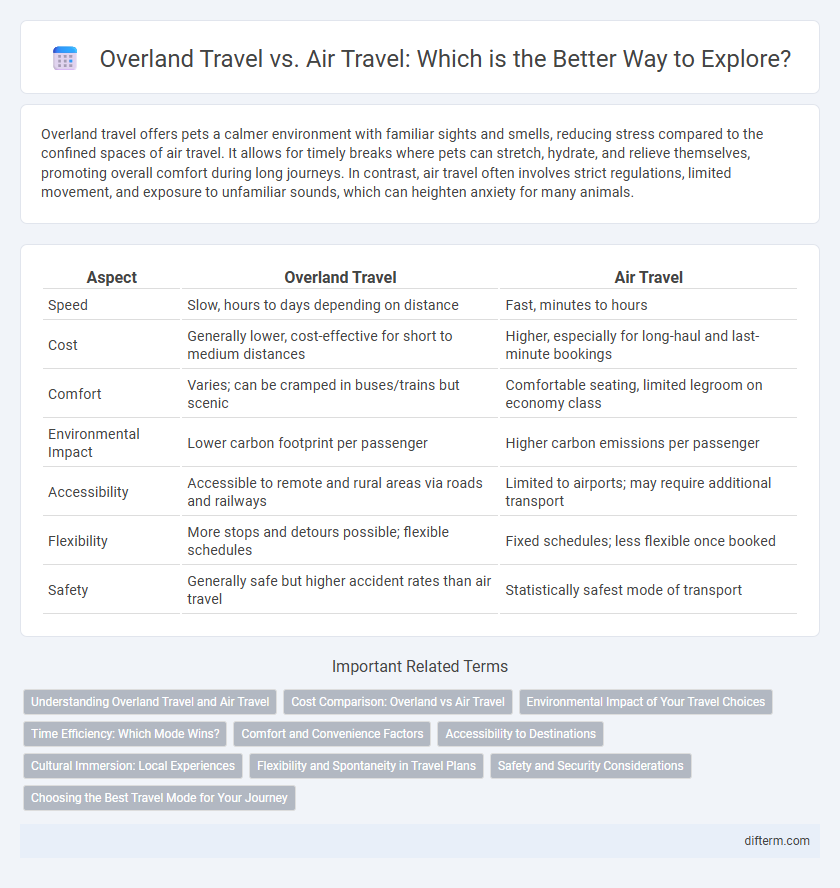Overland travel offers pets a calmer environment with familiar sights and smells, reducing stress compared to the confined spaces of air travel. It allows for timely breaks where pets can stretch, hydrate, and relieve themselves, promoting overall comfort during long journeys. In contrast, air travel often involves strict regulations, limited movement, and exposure to unfamiliar sounds, which can heighten anxiety for many animals.
Table of Comparison
| Aspect | Overland Travel | Air Travel |
|---|---|---|
| Speed | Slow, hours to days depending on distance | Fast, minutes to hours |
| Cost | Generally lower, cost-effective for short to medium distances | Higher, especially for long-haul and last-minute bookings |
| Comfort | Varies; can be cramped in buses/trains but scenic | Comfortable seating, limited legroom on economy class |
| Environmental Impact | Lower carbon footprint per passenger | Higher carbon emissions per passenger |
| Accessibility | Accessible to remote and rural areas via roads and railways | Limited to airports; may require additional transport |
| Flexibility | More stops and detours possible; flexible schedules | Fixed schedules; less flexible once booked |
| Safety | Generally safe but higher accident rates than air travel | Statistically safest mode of transport |
Understanding Overland Travel and Air Travel
Overland travel involves journeying by land-based transportation such as cars, buses, or trains, offering scenic routes and flexible stopovers ideal for exploring diverse landscapes and local cultures. Air travel provides rapid transit across long distances, prioritizing speed and efficiency, with extensive global flight networks connecting major cities and remote destinations alike. Both modes differ significantly in environmental impact, cost structures, and travel experience, which influence travelers' preferences based on itinerary and purpose.
Cost Comparison: Overland vs Air Travel
Overland travel generally offers lower costs compared to air travel, especially for short to medium distances where expenses such as fuel, tolls, and accommodation can be minimized by traveling during the day. Airlines often include additional fees for baggage, seat selection, and in-flight services, which can significantly increase the total cost of flying. Budget-conscious travelers frequently choose buses, trains, or carpooling to reduce expenses, making overland travel a cost-effective alternative to air travel.
Environmental Impact of Your Travel Choices
Overland travel significantly reduces carbon emissions compared to air travel, with trains and buses producing up to 80% less CO2 per passenger mile. Choosing overland options like railways supports sustainable tourism by minimizing fossil fuel consumption and decreasing overall environmental pollution. Sustainable travel planners often prioritize land routes to lower the ecological footprint of their journeys.
Time Efficiency: Which Mode Wins?
Overland travel offers flexibility and scenic routes but often requires significantly more time compared to air travel, especially for long distances. Air travel consistently ranks higher in time efficiency, reducing journey durations from days to mere hours. For travelers prioritizing speed, air travel remains the superior choice.
Comfort and Convenience Factors
Overland travel offers greater comfort through spacious seating, the ability to move freely, and scenic views, making long journeys more pleasant. Air travel, while faster, often involves strict security protocols, limited legroom, and potential delays, impacting convenience and overall comfort. Choosing between the two depends on balancing the need for speed with personal comfort preferences during travel.
Accessibility to Destinations
Overland travel offers unparalleled accessibility to remote and off-the-beaten-path destinations often unreachable by air, including rural villages and scenic landscapes connected by road networks. Air travel primarily serves major cities and hubs, limiting access to regions without airports or reliable ground transportation. Travelers seeking immersive experiences in less accessible areas benefit from the flexibility and extensive reach of overland routes.
Cultural Immersion: Local Experiences
Overland travel allows for deeper cultural immersion by providing opportunities to interact with local communities, taste regional cuisines, and explore off-the-beaten-path destinations. Travelers experience authentic cultural practices and traditions firsthand, which are often missed when flying between cities. In contrast, air travel prioritizes speed over the rich, immersive experiences that define the essence of local culture.
Flexibility and Spontaneity in Travel Plans
Overland travel offers unmatched flexibility by allowing travelers to easily change routes, stop at spontaneous locations, and explore less accessible areas not served by flights. Air travel requires strict adherence to fixed schedules, limiting the ability to alter plans on short notice and reducing opportunities for unplanned adventures. The freedom to adapt travel itineraries in real time makes overland journeys ideal for those seeking spontaneity and personalized exploration.
Safety and Security Considerations
Overland travel offers increased control over personal safety by allowing travelers to avoid crowded airports and minimize exposure to airborne illnesses, making it a preferred option during health crises. Air travel undergoes rigorous security screenings and benefits from advanced technological surveillance systems, providing a high level of protection against threats despite occasional concerns about in-flight medical emergencies. Both modes require vigilance, but overland routes often enable easier access to emergency services and flexible detour options in case of security issues, enhancing overall traveler safety.
Choosing the Best Travel Mode for Your Journey
Overland travel offers immersive experiences through scenic landscapes and cultural encounters, ideal for those seeking adventure and flexibility. Air travel provides unmatched speed and convenience, making it the preferred choice for long distances and time-sensitive trips. Evaluating factors such as travel time, budget, environmental impact, and personal comfort helps determine the best travel mode for your journey.
Overland travel vs Air travel Infographic

 difterm.com
difterm.com